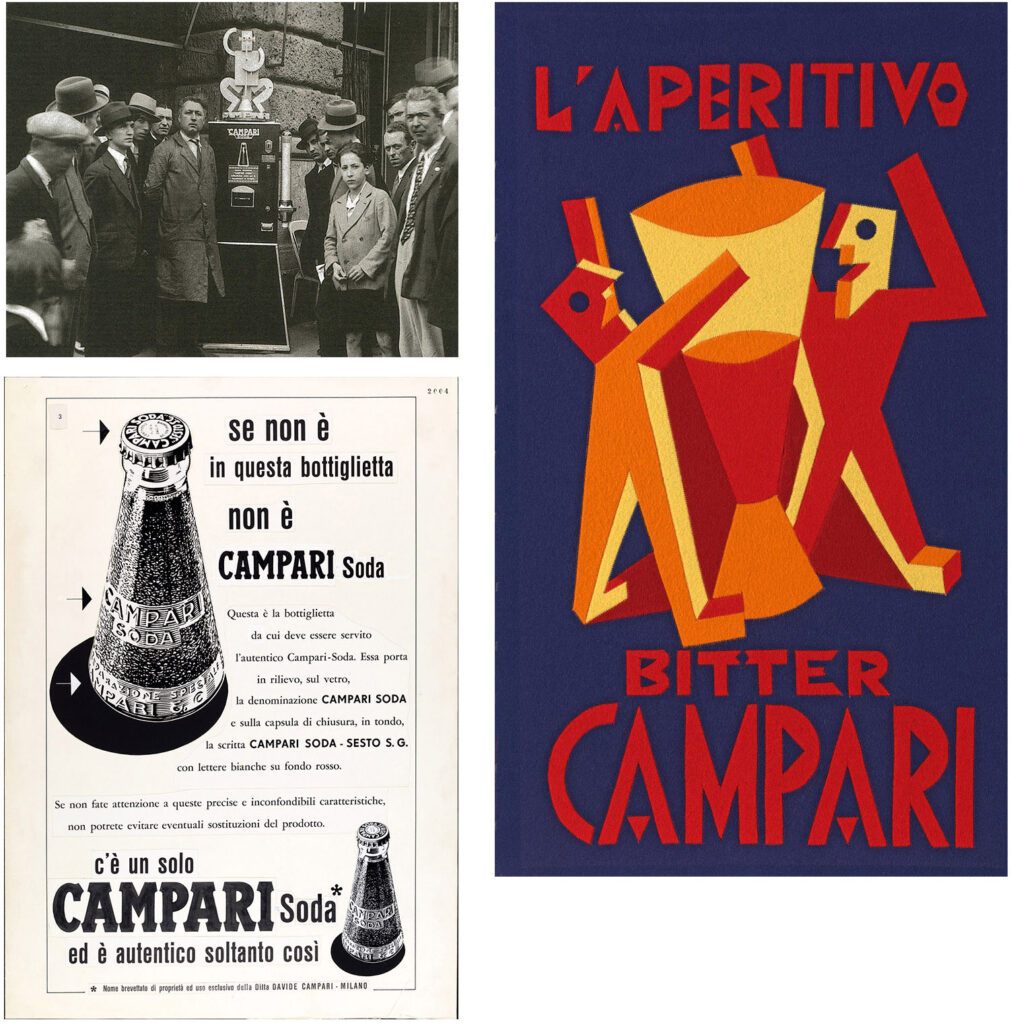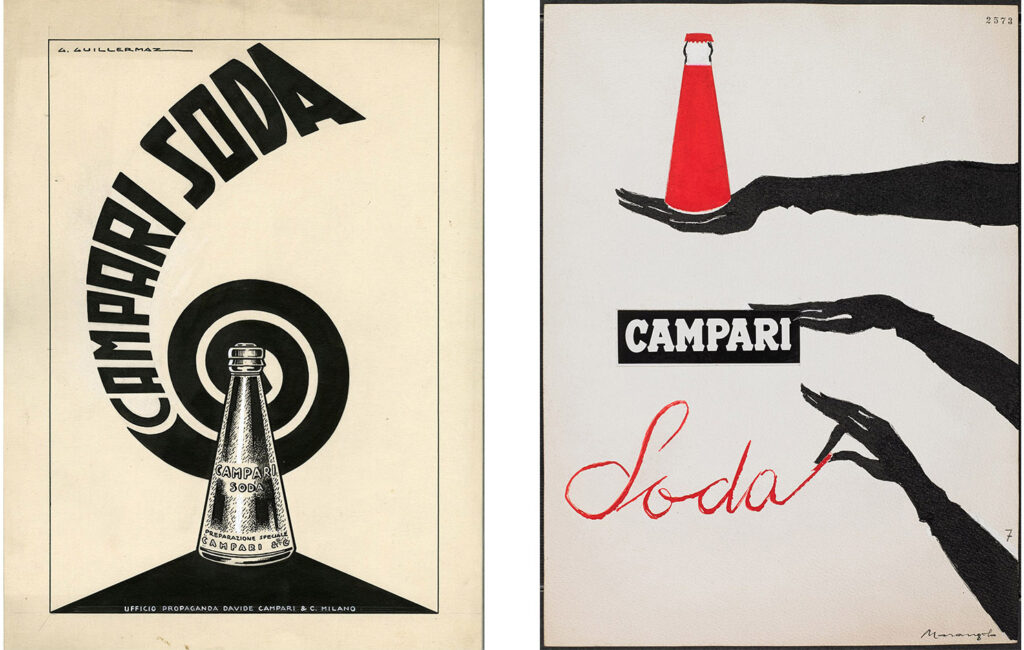Discover our e-shop and access a digital catalogue of over 40.000 design products.
Go to shop21 March 2022

Born to epitomize the ritual of the aperitif, the Campari Soda bottle has always been a modern and vibrant icon. Its contemporary and effective shape has freed it from aging, highlighting the unique beauty of its striking simplicity. Celebrated through art, design and cinema, it has become a brand itself: unlabeled, original, unmistakable, yet always ready to reinvent itself with irony and creativity.
“A lifetime is not enough, even for a single product.“
Davide Campari

The legend of Campari began in 1860, when Gaspare Campari invented his famous Bitter: the red aperitif was served in the Caffè Campari in Milan. His son Davide was a far-sighted visionary who promoted the industrial expansion of the family business through the opening of the Campari factory, at the beginning of the 20th century. He narrowed the range of products to a more strategic and competitive selection, and in 1915 he opened Il Camparino, a refined and modern venue which marked the birth of the Milanese aperitif ritual.
The exponential growth of the firm went hand in hand with the desire to create a bond with the art of the time, which found an effective expression in advertising through the significant and brilliant style of contemporary artists: the combination of avant-garde entrepreneurial intuition and the creative ferment of the time gave rise to new expressive languages, which marked the history of advertising communication in 1900.

Conceived to offer users the possibility to enjoy a fresh aperitif everywhere, savoring the uniqueness of Campari bitter and the fizz of soda, Campari Soda is the first ready-to-drink aperitif, and its iconic bottle describes its groundbreaking idea.
Designed in 1932 by futurist Fortunato Depero, the bottle contains a single portion of the product, guarantees its authenticity and can be easily chilled: a modern example of functional design which, thanks to the artist’s astounding creativity, draws a truncated cone in the form of an imaginary inverted goblet. It is unlabeled, featuring the name embossed on the glass; the intense and bright red of Campari Soda completes this creation that becomes, with its ingenious and bold simplicity, an unmistakable and iconic brand.

Even the frosted surface of the glass is part of Depero’s futuristic mindset, echoing the references to tactile materials mentioned by Marinetti in 1921 in his “Manifesto of Tactilism”. The frosted surface suggests the freshness of the product by simulating drops, and it also has the practical function of providing a better grip.
All the senses are involved in the Campari Soda experience: the taste of the drink, the sense of smell triggered by the scents, the sound of the fizz once the cap is removed, and, before all these, the aesthetic and tactile pleasure of the bottle. The container has the same communicative power as the content, thus making the Campari Soda bottle an example of modern design; since its conception, it has been revealing all its communicative power by itself.

Depero designed for the company a comprehensive communication strategy: he created numerous high- impact posters, playing with lettering, bold lines and the typical deconstruction of his artistic movement. He also conceived a range of “furnishings”: decorative objects, exhibition stands, and everything that today we would consider a gadget; his idea of advertising communication can be found in any concept or content. The bottle is also available in vending machines that keep it cold, with a wooden figure on top designed by the artist.
Campari Soda was launched through a communication strategy based on the unique nature of its iconic bottle: original, unmistakable and desirable. The success of the product is astounding, its reintroduction after World War II implied the strengthening of production structures to meet market demand.


Advertising had a crucial function: simple, fresh messages and simple, immediate design. Like the one by George Guillermaz: a futuristic spiral lettering that unfolds from the bottle. During the economic boom years, Campari Soda became the ultimate Italian aperitif, and artists contributed to the creation of a dynamic and modern image of a cutting-edge pop icon.
The bottle fits perfectly into graphic compositions: Mingozzi’s interplay of conical shapes echoes the original idea of the inverted goblet; Marangolo and Cavalieri’s images place the bottle in a range of human contexts and attitudes; other artists interpret its essential design as the sole protagonist of the scene.


After 1970, Campari debuted on television: Nino Manfredi was the protagonist of the commercial promoting the red aperitif, followed by Hollywood star David Niven, who granted Campari Soda worldwide fame. Since the 1980s, Campari has been collaborating in its commercials with renowned film directors and investing in brilliant dedicated collections.

Design within design, as for the famous Campari Light, suspension lamp, conceived in 2002 by Raffaele Celentano for Ingo Maurer (cover photo). The ten original bottles that compose the lamp really contain Campari Soda and can be removed and replaced individually; the support recalls the shape of a juicer, the cord to adjust the height features a real Campari bottle cap. A design icon that turns into a captivating pop lamp, blending together irony and aesthetics.

In 2008, the REDesign project asked artists to create a series of installations for the Triennale di Milano. To celebrate the 80th anniversary of Campari Soda, designer Matteo Ragni reissued the historic little bottle, and two years later it was given neon shades: a burst of color expressing its sparkling and unique personality. In 2016, it was wrapped in red Velcro, allowing the little bottles to come together in countless compositions as a tribute to friendship.

On the occasion of the Design Connection project in 2020, Campari entrusted three emerging designers with the creation of three furniture items inspired by the iconic shape of the Campari Soda bottle, and in the same year it celebrated its roots with the production of a glass inspired by Fortunato Depero’s futurist sketch.
Throughout its long history, Campari has turned its bond with the art of that time into the key to innovative and successful communication. A symbol of innovation and of a dynamic and forward-looking Milan, it has condensed into the conical shape of the Campari Soda bottle, conceived by the genius of futurist Depero, all the communicative impact that still glows today, 90 years after its creation.
Customize and receive your board, share it with whomever you want or with a Mohd Designer to get information and assistance.
After you send the first one, you can create new boards. There is no limit to your inspiration.
I got it, continue
Send in the form, you will receive an email with a link to your board with the products you have selected.
Share your inspiration with your partner and friends, or with a Mohd designer to get more information.
After you send the first board, you can create new ones. And if this board no longer inspires you, you can reset and start again.
We have sent you an email with a link to your board with the products you have selected.
Close